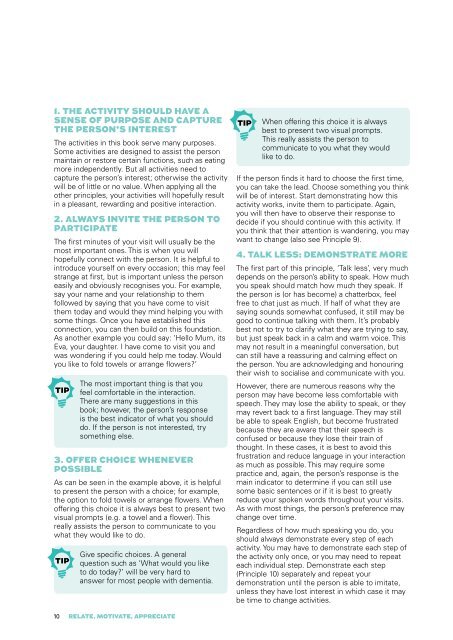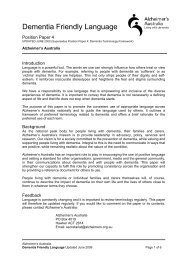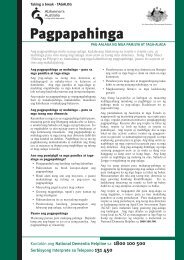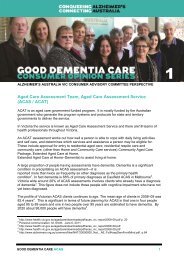RELATE, MOTIVATE, APPRECIATE - Alzheimer's Australia
RELATE, MOTIVATE, APPRECIATE - Alzheimer's Australia
RELATE, MOTIVATE, APPRECIATE - Alzheimer's Australia
You also want an ePaper? Increase the reach of your titles
YUMPU automatically turns print PDFs into web optimized ePapers that Google loves.
1. The activity should have a<br />
sense of purpose and capture<br />
the person’s interest<br />
The activities in this book serve many purposes.<br />
Some activities are designed to assist the person<br />
maintain or restore certain functions, such as eating<br />
more independently. But all activities need to<br />
capture the person’s interest; otherwise the activity<br />
will be of little or no value. When applying all the<br />
other principles, your activities will hopefully result<br />
in a pleasant, rewarding and positive interaction.<br />
2. Always invite the person to<br />
PARTICIPATE<br />
The first minutes of your visit will usually be the<br />
most important ones. This is when you will<br />
hopefully connect with the person. It is helpful to<br />
introduce yourself on every occasion; this may feel<br />
strange at first, but is important unless the person<br />
easily and obviously recognises you. For example,<br />
say your name and your relationship to them<br />
followed by saying that you have come to visit<br />
them today and would they mind helping you with<br />
some things. Once you have established this<br />
connection, you can then build on this foundation.<br />
As another example you could say: ‘Hello Mum, its<br />
Eva, your daughter. I have come to visit you and<br />
was wondering if you could help me today. Would<br />
you like to fold towels or arrange flowers?’<br />
The most important thing is that you<br />
feel comfortable in the interaction.<br />
There are many suggestions in this<br />
book; however, the person’s response<br />
is the best indicator of what you should<br />
do. If the person is not interested, try<br />
something else.<br />
3. Offer choice whenever<br />
possible<br />
As can be seen in the example above, it is helpful<br />
to present the person with a choice; for example,<br />
the option to fold towels or arrange flowers. When<br />
offering this choice it is always best to present two<br />
visual prompts (e.g. a towel and a flower). This<br />
really assists the person to communicate to you<br />
what they would like to do.<br />
Give specific choices. A general<br />
question such as ‘What would you like<br />
to do today?’ will be very hard to<br />
answer for most people with dementia.<br />
When offering this choice it is always<br />
best to present two visual prompts.<br />
This really assists the person to<br />
communicate to you what they would<br />
like to do.<br />
If the person finds it hard to choose the first time,<br />
you can take the lead. Choose something you think<br />
will be of interest. Start demonstrating how this<br />
activity works, invite them to participate. Again,<br />
you will then have to observe their response to<br />
decide if you should continue with this activity. If<br />
you think that their attention is wandering, you may<br />
want to change (also see Principle 9).<br />
4. Talk less; demonstrate more<br />
The first part of this principle, ‘Talk less’, very much<br />
depends on the person’s ability to speak. How much<br />
you speak should match how much they speak. If<br />
the person is (or has become) a chatterbox, feel<br />
free to chat just as much. If half of what they are<br />
saying sounds somewhat confused, it still may be<br />
good to continue talking with them. It’s probably<br />
best not to try to clarify what they are trying to say,<br />
but just speak back in a calm and warm voice. This<br />
may not result in a meaningful conversation, but<br />
can still have a reassuring and calming effect on<br />
the person. You are acknowledging and honouring<br />
their wish to socialise and communicate with you.<br />
However, there are numerous reasons why the<br />
person may have become less comfortable with<br />
speech. They may lose the ability to speak, or they<br />
may revert back to a first language. They may still<br />
be able to speak English, but become frustrated<br />
because they are aware that their speech is<br />
confused or because they lose their train of<br />
thought. In these cases, it is best to avoid this<br />
frustration and reduce language in your interaction<br />
as much as possible. This may require some<br />
practice and, again, the person’s response is the<br />
main indicator to determine if you can still use<br />
some basic sentences or if it is best to greatly<br />
reduce your spoken words throughout your visits.<br />
As with most things, the person’s preference may<br />
change over time.<br />
Regardless of how much speaking you do, you<br />
should always demonstrate every step of each<br />
activity. You may have to demonstrate each step of<br />
the activity only once, or you may need to repeat<br />
each individual step. Demonstrate each step<br />
(Principle 10) separately and repeat your<br />
demonstration until the person is able to imitate,<br />
unless they have lost interest in which case it may<br />
be time to change activities.<br />
10<br />
<strong>RELATE</strong>, <strong>MOTIVATE</strong>, <strong>APPRECIATE</strong>

















